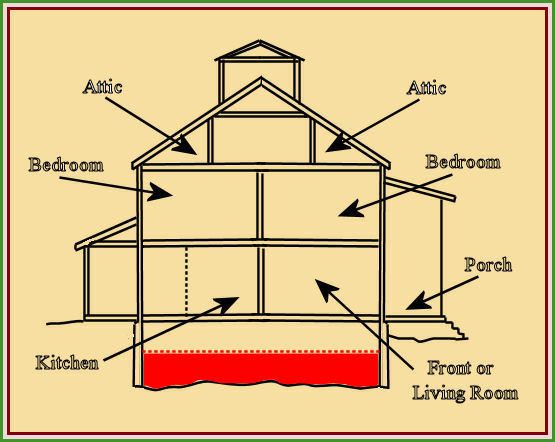

![]() In modern houses, the word cellar is the name given to the room underneath the main floor. It is where the heating furnace, water pump, and other utilities service equipment are located. It also functions as a storage space because so few houses have attics large enough for that purpose. Although the cellar is still a common room, it’s ancestor, the root cellar has virtually vanished as a result of the improvements in refrigeration. The name cellar comes from the Latin word cellarium referring to food storage. The addition of the word root refers to the fact that it was primarily potatoes, turnips, yams and other ‘root vegetables’ that were stored there. Apples and pears were commonly stored in the root cellar also. The root cellar was located underneath the house because of the fact that during the summer it was cool, and during the winter the temperature did not go below freezing. Unlike modern houses, with cemented floors, cellars in early houses seldom were cemented. The bare earthen floors were very easily spaded up and the vegetables or fruit would be packed in among the loosened soil, waiting to be retrieved and enjoyed in the dead of winter.
In modern houses, the word cellar is the name given to the room underneath the main floor. It is where the heating furnace, water pump, and other utilities service equipment are located. It also functions as a storage space because so few houses have attics large enough for that purpose. Although the cellar is still a common room, it’s ancestor, the root cellar has virtually vanished as a result of the improvements in refrigeration. The name cellar comes from the Latin word cellarium referring to food storage. The addition of the word root refers to the fact that it was primarily potatoes, turnips, yams and other ‘root vegetables’ that were stored there. Apples and pears were commonly stored in the root cellar also. The root cellar was located underneath the house because of the fact that during the summer it was cool, and during the winter the temperature did not go below freezing. Unlike modern houses, with cemented floors, cellars in early houses seldom were cemented. The bare earthen floors were very easily spaded up and the vegetables or fruit would be packed in among the loosened soil, waiting to be retrieved and enjoyed in the dead of winter.
![]() Some root cellars were not located underneath the house, but apart from it and often adjoining a well or spring house. Over time, the outside cellar was increased in height to accommodate the storage of more and more produce, especially of corn and other grains. At first, the increase in height took the resemblance of a simple shed atop the cellar. As the height of the shed increased, the function was retained, but the name was altered to become silo, an out-building that would become a symbol of the American farm.
Some root cellars were not located underneath the house, but apart from it and often adjoining a well or spring house. Over time, the outside cellar was increased in height to accommodate the storage of more and more produce, especially of corn and other grains. At first, the increase in height took the resemblance of a simple shed atop the cellar. As the height of the shed increased, the function was retained, but the name was altered to become silo, an out-building that would become a symbol of the American farm.
![]() In the diagram below, the root cellar is indicated in red.
In the diagram below, the root cellar is indicated in red.

